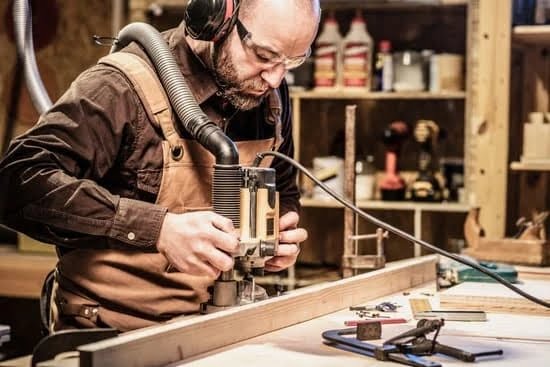A strong and reliable workbench is the backbone of any woodworking shop. Whether you are a professional woodworker or a hobbyist, having a well-built and sturdy workbench is essential for achieving high-quality craftsmanship. This article will guide you through the process of making your own woodworking workbench, from understanding its key components to choosing the right materials and constructing it step-by-step.
A good workbench provides stability, support, and ample workspace to facilitate precision and efficiency in every woodworking project. It is not only a surface to work on but also serves as a storage and organizational solution for tools and materials. With a solid workbench at your disposal, you can confidently tackle any woodworking task with ease.
In this comprehensive guide, we will delve into the anatomy of a woodworking workbench, explaining each component’s purpose and how they contribute to enhancing your craftsmanship. We will also provide you with a detailed list of tools and materials required to build your own workbench from scratch. Additionally, we’ll give you valuable tips on selecting the perfect lumber for your project based on strength, durability, and cost-effectiveness.
So if you’re ready to take your woodworking skills to the next level by creating a customized workspace that meets all your needs, read on. From construction instructions to design options, maintenance tips to personalization ideas, this article has everything you need to know about making a woodworking workbench that will become the foundation of your craftmanship.
Understanding the Key Components
Workbench Top
The workbench top is arguably the most important component of a woodworking workbench. It provides a sturdy and flat surface for all your woodworking projects. The ideal workbench top is made from a dense and durable hardwood, such as beech or maple, which can withstand heavy use and resist damage from tools and materials.
Vises
Vises are essential components that enhance the functionality of a woodworking workbench. There are two main types of vises commonly used in workbenches: front vises and end vises. A front vise is typically located at the front edge of the workbench top, while an end vise is positioned at one end of the bench. These vises hold your workpiece firmly in place, allowing you to accurately and safely carry out various woodworking tasks.
Tool Well
A tool well is a recessed area on the surface of the workbench that provides convenient storage for frequently used hand tools. It keeps your tools within reach, organized, and protected from accidental damage. A tool well can be either integrated into the workbench top or added as a separate attachment.
Bench Dogs
Bench dogs are pegs or pins that fit into holes in the workbench top, creating a versatile clamping system. They allow you to secure your workpiece vertically or horizontally, providing stability during various woodworking operations such as planing, sawing, or chiseling.
Understanding these key components will help you choose or design a woodworking workbench that suits your specific needs and preferences. Whether you’re building it from scratch or purchasing a pre-made bench, ensure that these components are well-built and properly installed for optimal performance in your workshop space.
Tools and Materials Required
To begin building your woodworking workbench, it is essential to have the right tools and materials. Here is a comprehensive list of what you will need to gather before you start:
Tools
- Tape measure: Used for accurately measuring dimensions.
- Circular saw or table saw: Essential for cutting the lumber to the desired lengths.
- Drill/driver: Needed for drilling pilot holes and inserting screws.
- Chisels: Used for shaping and cleaning joints.
- Mallet or hammer: Necessary for driving chisels and assembling parts.
- Router: Helpful for adding decorative edges to your workbench.
- Clamps: Essential for holding pieces together during assembly.
- Level: Used to ensure your workbench is perfectly level.
Materials
- Lumber: The main material needed for building your workbench. Choose a hardwood such as maple, birch, or beech for durability.
- Plywood or MDF (medium-density fiberboard): Used for the work surface and shelves, providing stability and strength.
- Screws or bolts: Necessary for joining different components of the workbench together securely.
- Wood glue: Helps reinforce joints and add strength to the structure.
- Sandpaper or sanding blocks: Used to smooth rough edges and surfaces.
It is important to note that the specific quantities of tools and materials will vary depending on the size and design of your workbench. Make sure to measure your workspace carefully and consult your chosen woodworking project plan before purchasing any materials.
Once you have gathered all the necessary tools and materials, you will be ready to move on to the next step – choosing the right wood for your workbench.
Choosing the Right Wood
When it comes to building a woodworking workbench, one of the most important decisions you’ll need to make is choosing the right wood. The type of wood you select will not only determine the overall strength and durability of your workbench but also impact its appearance and longevity. Here are some tips for selecting the perfect lumber for your workbench:
- Hardwood vs Softwood: One of the first considerations when choosing wood for your workbench is whether to use hardwood or softwood. Hardwoods like oak, maple, and beech are generally preferred for their durability and resistance to wear and tear. Softwoods like pine, fir, and spruce, on the other hand, are more affordable but may require additional reinforcement for heavy-duty use.
- Grain Orientation: Another important factor to consider is the grain orientation of the wood. For a sturdy workbench that can withstand heavy loads and resist warping or splitting, it’s recommended to choose boards with straight grain patterns. Avoid using boards with knots or irregular growth patterns as they may weaken the overall structure.
- Moisture Content: Properly seasoned wood is essential for minimizing warping or shrinking over time. It’s crucial to choose lumber with an appropriate moisture content suited for indoor use since excessive moisture can lead to swelling or distortion. Aim for wood that has been kiln-dried or air-dried to a moisture content of around 6-8%.
- Thickness and Width: The thickness and width of the lumber will depend on personal preference and the intended use of your workbench. Thicker boards provide more stability while wider boards offer more surface area for various projects. Consider what types of woodworking tasks you’ll be undertaking and choose dimensions that suit your needs.
By taking these factors into consideration, you can ensure that you choose the right wood for your woodworking workbench that meets both functional and aesthetic requirements.
| Tips for Selecting the Perfect Lumber for your Workbench |
|---|
| 1. Choose hardwood over softwood for increased durability and resistance to wear and tear. |
| 2. Look for straight grain patterns to ensure a sturdy structure. |
| 3. Opt for properly seasoned wood with a moisture content of around 6-8%. |
| 4. Consider the intended use of your workbench when selecting thickness and width. |
Step-by-Step Construction Guide
Gathering the Necessary Tools and Materials
Before you start building your workbench, it’s important to gather all the necessary tools and materials. Here is a comprehensive list of what you’ll need:
- Workbench Plans or Design: Start by finding a set of plans or design for your workbench. This will serve as your blueprint throughout the construction process.
- Lumber: The main component of your workbench will be the lumber. Choose a high-quality hardwood such as oak, maple, or birch that is sturdy and can withstand heavy use.
- Plywood or MDF: You’ll also need plywood or medium-density fiberboard (MDF) for creating the top surface of your workbench. Make sure it is thick enough to provide stability and support.
- Screws, Nails, and Fasteners: To hold everything together, you’ll need an assortment of screws, nails, and other fasteners. Opt for high-quality options that are durable and provide strong connections.
- Wood Glue: Using wood glue in addition to fasteners can provide added strength to your workbench joints.
- Clamps: Clamps are essential for holding pieces together while the glue dries or when assembling various parts of the workbench.
- Measuring Tools: A tape measure, square ruler, and level will ensure accurate measurements during construction.
- Power Tools: Depending on your comfort level with power tools, you may need a circular saw or jigsaw for cutting lumber, a drill/driver for making holes and driving screws, and a sander for smoothing out rough edges.
- Safety Equipment: Don’t forget to prioritize safety by wearing protective eyewear, gloves, and ear protection when using power tools.
Building Your Workbench Step-by-Step
Now that you have all the necessary tools and materials ready, it’s time to start building your workbench. Follow these step-by-step instructions:
- Prepare the Lumber: Cut your lumber according to the measurements specified in your workbench plans. Sand any rough edges or surfaces.
- Assemble the Workbench Frame: Start by constructing the frame of your workbench using the prepared lumber and screws. Use clamps and corner braces for added stability.
- Attach the Legs: Once you have your frame, attach the legs to each corner securely using screws or bolts.
- Create the Top Surface: Cut a piece of plywood or MDF to fit over the frame as your workbench top. Secure it with screws and wood glue, ensuring a flush surface.
- Add Additional Supports: To strengthen your workbench, consider adding cross supports on each side between the legs. This will prevent any wobbling or instability.
- Install Drawers or Shelves (Optional): If desired, add drawers or shelves to provide storage space for tools and materials.
- Apply Finish (Optional): If you want to protect your workbench and enhance its appearance, you can apply a finish such as varnish, stain, or paint.
Remember to follow the instructions provided in your chosen workbench plans or design throughout each step of construction for optimal results. Take your time and double-check measurements and connections to ensure a sturdy and well-built workbench that will serve you for years to come.
Workbench Design Options
When it comes to designing your woodworking workbench, there are a multitude of options to consider. The design of your workbench will ultimately depend on your individual preferences and the type of projects you plan on working on. Here are some different styles and features to explore that will help you create a workbench perfectly suited to your woodworking needs.
One popular style is the traditional European-style workbench, which typically features a thick, sturdy top made from hardwood such as beech or maple. This style often incorporates a front vise and tail vise for holding pieces securely while working on them. The European-style workbench also commonly includes tool storage options such as drawers or shelves, allowing for easy access to frequently used tools.
Another option to consider is a modern hybrid workbench design, which combines the characteristics of both traditional and contemporary designs. These hybrid workbenches often feature a solid wood top combined with elements like metal legs or threaded rod for added stability. They may also incorporate features such as adjustable height mechanisms or built-in clamping systems for enhanced versatility.
For those with limited space or who plan on moving their workbench frequently, a portable workbench design may be the best choice. These compact benches are usually lightweight but still offer sufficient surface area for most woodworking projects. Portable workbenches often include folding legs and can easily be stored away when not in use.
In addition to the overall style of your workbench, it’s important to think about any specific features that would benefit your particular woodworking needs. Consider elements such as built-in power outlets for easy access to electricity, integrated dust collection systems to keep your workspace clean, or additional storage options for organizing tools and materials.
By exploring different styles and features, you can create a custom-designed workbench that is tailor-made for your woodworking projects. Remember to take into account factors such as available space, budget constraints, and personal preferences when deciding on the design that best suits your needs. With the right workbench design, you’ll be well-equipped to tackle any woodworking project that comes your way.
Must-Have Accessories
A well-equipped workbench is not complete without a set of essential accessories that enhance efficiency and organization in your woodworking projects. These accessories provide convenient storage solutions, help keep tools within reach, and improve workflow. Here are some must-have accessories to consider adding to your woodworking workbench:
- Tool Storage: Properly storing your tools not only increases their lifespan but also helps you stay organized. Consider adding a tool rack or pegboard to hang frequently used hand tools such as hammers, screwdrivers, chisels, and pliers. This not only keeps them easily accessible but also frees up valuable countertop space.
- Clamp System: Clamps are indispensable in any woodworking project, and having a well-designed clamp system can greatly improve efficiency. Consider installing a clamp rack or designated slots on the sides or back of your workbench to keep different types and sizes of clamps neatly organized and easily accessible.
- Bench Vise: A bench vise is an essential accessory for any woodworking workbench. It securely holds the workpiece in place while you cut, drill, shape, or assemble it. There are various types of bench vises available including front vises, tail vises, and side vises. Choose one that suits your specific needs and install it securely onto your workbench.
- Power Outlets: In today’s world of power tools, having conveniently placed power outlets on your workbench can save time and hassle. Install multiple power outlets along the sides or back of your workbench at a height that allows easy plugin for your tools without bending down or stretching cords across the workspace.
- Storage Drawers or Cabinets: Additional storage options like drawers or cabinets can add functionality to your workbench by providing ample space for storing smaller tools, hardware, paintbrushes, safety glasses, and other woodworking essentials. Consider incorporating drawers or cabinets beneath your workbench or as modules attached to the sides.
By adding these essential accessories to your woodworking workbench, you not only enhance the functionality of your workspace but also improve efficiency and organization in your projects. Customizing your workbench with these must-have accessories ensures that you always have everything within reach and can complete your woodworking tasks with ease.
Maintenance and Longevity
Maintaining and caring for your woodworking workbench is essential to ensure its durability and quality over time. By following some simple tips, you can keep your workbench in top condition and ensure that it continues to serve you well for many years to come.
- Clean Regularly: It’s important to keep your workbench clean from sawdust, debris, and any spills that may occur during your woodworking projects. Regularly sweep or vacuum the surface of the bench to remove any loose particles. If there are stubborn stains or spills, use a mild detergent and warm water to gently wash the surface. Avoid using harsh chemicals or abrasive cleaners as they can damage the finish of the wood.
- Protect from Moisture: Wood is highly susceptible to moisture, which can cause warping, swelling, or even rotting of your workbench. To protect against moisture damage, it’s important to avoid placing your workbench in areas with high humidity or direct exposure to water sources. Additionally, consider applying a protective sealant or finish to the wood surface of your workbench to create a barrier against moisture.
- Maintain Proper Support: Over time, the joints and connections of your workbench may begin to loosen due to constant use and heavy loads. To ensure the longevity of your bench, regularly check for any loose bolts or screws and tighten them as needed. If you notice any significant structural issues, such as wobbling or instability, consider reinforcing or repairing those areas promptly.
- Protect from Excessive Heat: Extreme heat can cause wood to expand and potentially weaken its structure over time. Keep your workbench away from direct sunlight or heat sources such as heaters or stoves. If you’re working with hot tools like soldering irons or heat guns on your bench surface, use appropriate heat-resistant pads or insulation materials to protect the wood.
- Prevent Damage from Sharp Tools: Your workbench is likely to come into contact with sharp tools, such as chisels or saws, which can accidentally cause scratches or nicks on the surface. To protect your workbench from tool damage, consider using a protective mat or installing a sacrificial layer made of hardwood on the top surface. This sacrificial layer can be easily replaced when it becomes too damaged.
Following these maintenance tips will ensure that your woodworking workbench remains in excellent condition and provides you with a solid and reliable foundation for all your future projects. By caring for your workbench, you’re not only preserving its durability and quality but also ensuring that it continues to support your craftsmanship for many years to come.
Personalizing Your Workbench
Once you have built your woodworking workbench, it’s time to make it truly your own by adding some creative and personalized touches. Personalizing your workbench not only adds a unique flair but also enhances its functionality and efficiency. Here are some creative ideas to customize your workbench:
- Tool Storage Solutions: One of the most common ways to personalize a workbench is by adding storage solutions for your tools. Consider installing pegboards or tool holders on the walls of your workbench to keep your frequently used tools within easy reach. You can also attach magnetic strips or hooks to hold small hand tools or screwdrivers. Additionally, installing drawers or shelves underneath the work surface can help keep larger tools or materials organized.
- Integrated Lighting: Proper lighting is essential for any woodworking project, especially when working with intricate details. To personalize your workbench further, consider adding integrated lighting solutions such as LED strip lights under the upper shelf or surface-mounted task lights that can be adjusted according to your needs. This will not only improve visibility but also create a professional-looking workspace.
- Customized Signage: Adding a personalized signage or nameplate to your workbench can give it a professional touch and make it truly yours. You can carve or engrave your name onto a wooden plaque and attach it to the front of the bench using screws or adhesive. Alternatively, you could use stencils and paint to write your name or favorite woodworking quote on the sides of the bench.
- Comfort Upgrades: Woodworking often involves long hours of standing at the bench, so consider making it more comfortable by adding cushions or padding to the seat or backrest areas. You can upholster these areas with durable fabric in colors that match your workshop decor.
Remember, personalizing your workbench should not compromise its functionality and practicality; rather, it should enhance your woodworking experience. Take the time to choose customization options that align with your needs and preferences, and enjoy the sense of ownership and pride that comes with having a personalized workbench in your workshop.
Conclusion
In conclusion, completing the construction of your woodworking workbench marks a significant milestone in your journey as a woodworker. It represents the culmination of your efforts and signals the beginning of endless possibilities for creativity and craftsmanship. Your workbench is not just an ordinary piece of furniture; it is the foundation upon which you will build your projects and hone your skills.
By understanding the key components, acquiring the necessary tools and materials, choosing the right wood, and following the step-by-step construction guide, you have successfully created a workspace that is tailored to meet your woodworking needs. With its sturdy construction and thoughtful design, your workbench will provide you with a stable surface to perform various tasks such as cutting, shaping, assembling, and finishing.
One of the beauties of building your own workbench is the ability to personalize it according to your preferences and style. From adding storage options for organizing tools and supplies to incorporating unique features like vises or built-in clamps, you can truly make it your own. Embrace this opportunity for customization and consider adding creative touches that reflect your personality and inspire you while working.
As you begin using your completed workbench, remember that proper maintenance is essential for ensuring its durability and longevity. Regularly inspecting it for any signs of wear or damage and addressing them promptly will help preserve its quality over time. Furthermore, maintaining cleanliness on the surface and keeping it free from excessive moisture will also contribute to its overall longevity.
With your workbench in place, you are now ready to embark on countless woodworking projects. Whether you are a seasoned professional or just starting out, this essential tool will support you in bringing your ideas to life with precision and skill. So take a moment to celebrate the completion of your woodworking workbench because from here onwards, there are no limits – only endless possibilities waiting to be explored.
Frequently Asked Questions
Is it cheaper to buy or build a workbench?
Whether it is cheaper to buy or build a workbench depends on various factors. If you have the necessary woodworking skills and tools, building a workbench can be more cost-effective. By sourcing materials at a lower cost and considering recycled or repurposed items, you can save money.
Additionally, customizing the size and features of the workbench to suit your specific needs without paying for unnecessary extras can result in savings. However, if you lack woodworking skills or require a highly specialized workbench, purchasing one may provide better value in terms of time and effort saved.
What type of wood should I use for a workbench?
When selecting wood for a workbench, it is crucial to choose a type that is durable, sturdy, and able to withstand heavy use. Hardwoods like maple, beech, or birch are often recommended due to their strength and resistance to wear and tear. These woods offer superior hardness and stability compared to softwoods such as pine or fir which may dent or warp more easily under pressure.
Additionally, hardwoods generally have tighter grains that provide a smoother surface for various tasks like woodworking or assembly projects. Considering the budget, availability, and personal preferences are also important factors while choosing the right type of wood for your workbench.
How many 2×4 do I need for a workbench?
The number of 2x4s required for building a workbench will depend on its dimensions and design. Typically, a basic workbench will need at least four 8-foot long 2×4 boards to construct the legs and frame securely. This assumes each leg consists of two 2x4s with two additional pieces forming the crossbeam support between them for added stability.
For longer benches or those requiring additional framing elements like shelves or drawers underneath, more 2x4s will be needed accordingly. It’s essential to plan out your workbench design carefully before determining the exact quantity of 2x4s needed in order to ensure adequate structural integrity during construction.

Hi everyone! I’m a woodworker and blogger, and this is my woodworking blog. In my blog, I share tips and tricks for woodworkers of all skill levels, as well as project ideas that you can try yourself.





